Of all the team sports adapted to computer gaming, only baseball can boast the unrivaled consistency of wearing nearly the same interface for over twenty-five years. As early as 1983, games like Color Baseball for the TRS-80 mapped the cardinal directions of the Tandy Joystick to the four bases of the infield diamond.
Color Baseball also featured a top-down view of the entire field that persists in today's lastest games. The context-sensitive control scheme follows the movement of the ball around the field. When a hit leaves the infield, the focus naturally switches to the outfielders. And after a player fields the ball, the position of the joystick indicates to which base it will be thrown.
To quote one reviewer, "everything just seems to make sense on-screen."
By 1987, the ideal interface for a 2-player computer game adaptation of baseball is firmly in place, as demonstrated by RBI Baseball for the NES. The primary innovation over Color Baseball is the differentiated pitching and fielding scenarios. Like a typical TV broadcast, much of the game is presented as a one-on-one duel between pitcher and hitter. Various statistics and cropped views of the field adorn the central channel but the perspective does not change until either the batter makes contact with a pitch or the pitcher attempts to pick off a baserunner.
Notably, both views feature the same orientation such that "down" on the gamepad maps to home plate, "up" maps to second base, and so on.
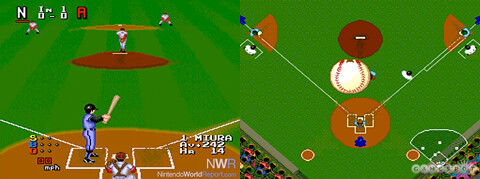
World Class Baseball, TurboGrafx-16, 1989
World Class Baseball for the TurboGrafx-16 improved upon RBI's two perspectives with flyballs that grew significantly larger and left clearly defined shadows on the field as they flew higher, making it much easier for players to judge where and when they might land. Additionally, this title provided fielders with a few fancy leaps and dives without sacrificing the simplicity of the minimal control scheme.
As seen above, multiplayer World Class Baseball gameplay hits the right sense of casual pleasure to approximate the sandlot, alleyway pickup game. And who doesn't like the cool Miami take on baseball stadium organ music?
Although visual conventions were firmly established in RBI Baseball and World Class Baseball, Baseball Stars is often remembered as the quintessential 1980's baseball title because of its sophisticated statistical system. RBI, like many games, was the product of a licensing arrangement with Major League Baseball and bore the names, logos, and likenesses of real teams and players. Baseball Stars, on the other hand, maintained a Little League baseball fiction in which gamers created their own players and teams that could be stored in cartridge memory and persist across multiple seasons.
Rumors abound of hardcore Baseball Stars fans who continue to maintain active teams after two decades of play.
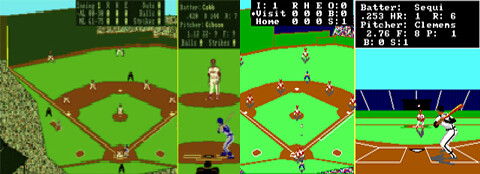
Earl Weaver Baseball, Amiga/ MS-DOS, 1987
At the end of the 1980s, baseball game designers began to experiment with the traditional interface. Earl Weaver Baseball, primarily a home PC title, offered simultaneous presentation of both perspectives by vertically splitting the screen. Weaver is also notable for its landmark AI, the product of numerous interviews between legendary manager Earl Weaver and the equally legendary game designer Don Daglow who wrote Baseball for the PDP-10 in 1971, the earliest known computer simulation of America's favorite game.
Other experiments were less successful. In particular, Roger Clemens MVP Baseball and the Bases Loaded series broke the persistent orientation rule established by earlier titles in an effort to present a more TV-like, multi-angle experience. In each of these games, the "camera angle" swung around such that they broke the dependable relationship between the gamepad's cardinal directions and the baseball diamond's bases.
(To get a sense for this disorienting new system, fast-forward the above video to about 1:15.)

MLB Power Pros, Wii/ PS2, 2007
The contemporary MLB Power Pros demonstrates the durability of those early baseball game innovations. It features an accumulative statistics system like Baseball Stars, major league licensing and cartoonish character design like RBI Baseball, and the simple play style of World Class Baseball.
MLB Power Pros Exhibition Match
by thetanooki
While efforts to adapt other sports continue to struggle to find working control schemes, baseball maintains a calm confidence. What are the characteristics of baseball and early console gaming that made effective adaptation possible? In what ways could it have gone off course?
Sports gamers tend to be an opinionated bunch. What titles did I miss?









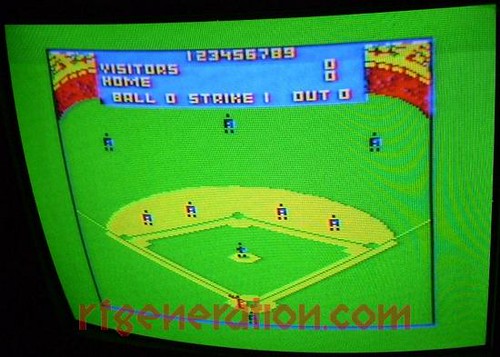
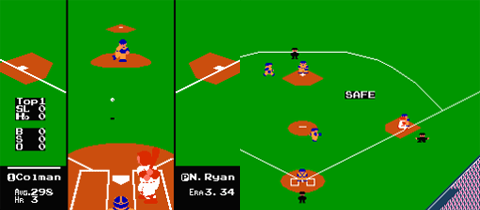
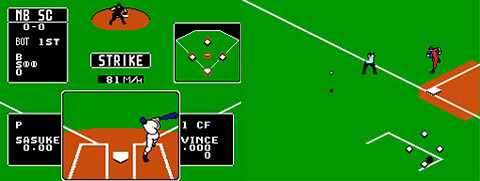
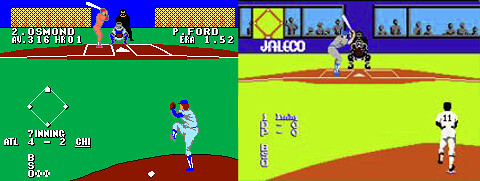
Pace may also have something to do with it. A faster-paced sport like football or hockey demands on-the-fly adjustments by a game player--leaving more need for developers to experiment.
Earl Weaver Baseball is an example of the extreme opposite: pace was rendered irrelevant by "manager mode" and--if I remember right--another mode where the computer played itself just so you could see what changes in stats would do for a team over the course of a season.